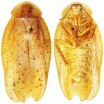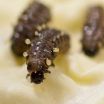Progesterone may be why pregnant women are more vulnerable to certain infections
New research published in the Journal of Leukocyte Biology shows that the progesterone receptor functions to regulate the helper T cells required for developing antibodies that protect humans against disease
2013-02-28
(Press-News.org) Bethesda, MD—Women who are pregnant or using synthetic progesterone birth control injections have a conspicuous vulnerability to certain infections including malaria, Listeria, HIV, and herpes simplex virus. A new research report appearing in the March 2013 issue of the Journal of Leukocyte Biology offers strong evidence for a possible explanation: the progesterone receptor, a pregnancy hormone sensor, targets a part of the immune system responsible for protection against these and other invaders. In addition to helping explain why some women are more vulnerable to certain infections, it also sheds light on why some autoimmune diseases, notably rheumatoid arthritis and multiple sclerosis, often go into remission during pregnancy.
"We hope that continued work in this area will ultimately yield better approaches to the prevention of immunological complications of pregnancy, safer and more effective forms of hormonal birth control and novel biological targets for the treatment of autoimmune diseases," said Grant C. Hughes, M.D., a researcher involved in the work from the Division of Rheumatology and Department of Immunology at the University of Washington in Seattle, WA.
To make their discovery, scientists used two groups of mice. The first group had a mutated progesterone receptor, or PR gene, which rendered the mice's bodies incapable of sensing progesterone through PR (PR knockout mice). The second group was comprised of normal mice. After various forms of immunization, antibody responses were tracked. When compared to normal mice, PR knockout mice produced much higher antibody levels, but only in response to forms of immunization requiring T cells, a cell type that normally boosts antibody production by B cells. This prompted a closer look at B and T cells from the PR knockout mice. The researcher saw that when stimulated in the test tube, knockout B cells showed normal, if not slightly less, antibody production compared to controls. On the other hand, knockout T cells stimulated in the test tube showed a conspicuous over-production of interferon-gamma, an inflammatory molecule involved in fighting off pregnancy-associated pathogens and in shaping protective antibody responses. Adding progesterone to the test tube blocked interferon-gamma in normal T cells, but not in PR knockout T cells. This suggests that progesterone suppresses interferon gamma in T cells through their PR. To sort out which aspects of the abnormal antibody responses in PR knockout mice were due to T cells, researchers immunized two groups of normal mice, one transplanted with responder T cells from PR knockout donors, the other with responder T cells from normal donors. Just like in PR knockout mice, normal mice transplanted with PR knockout responder T cells showed much higher antibody levels than normal mice.
"Pregnancy and hormones have long been known to influence immune responses, but these processes have been poorly understood, said John Wherry, Ph.D., Deputy Editor of the Journal of Leukocyte Biology. "This new work is significant for two reasons. First, the identification of progesterone receptors as a mechanism of immune modulation during pregnancy sheds light on the pregnancy-immune phenomenon, and second, these studies define a potentially new target to modulate autoimmunity and immune-mediated problems during pregnancy."
###
The Journal of Leukocyte Biology publishes peer-reviewed manuscripts on original investigations focusing on the cellular and molecular biology of leukocytes and on the origins, the developmental biology, biochemistry and functions of granulocytes, lymphocytes, mononuclear phagocytes and other cells involved in host defense and inflammation. The Journal of Leukocyte Biology is published by the Society for Leukocyte Biology.
Details: Grant C. Hughes, Edward A. Clark, and Alan H. Wong. The intracellular progesterone
receptor regulates CD4+ T cells and T cell-dependent antibody responses. J Leukoc Biol March 2013 93:369-375, doi:10.1189/jlb.1012491 ; http://www.jleukbio.org/content/93/3/369.abstract END
ELSE PRESS RELEASES FROM THIS DATE:
2013-02-28
PROVIDENCE, R.I. [Brown University] — A team of neuroengineers based at Brown University has developed a fully implantable and rechargeable wireless brain sensor capable of relaying real-time broadband signals from up to 100 neurons in freely moving subjects. Several copies of the novel low-power device, described in the Journal of Neural Engineering, have been performing well in animal models for more than year, a first in the brain-computer interface field. Brain-computer interfaces coud help people with severe paralysis control devces with their thoughts.
Arto Nurmikko, ...
2013-02-28
DURHAM, N.C. -- Researchers have electronically linked the brains of pairs of rats for the first time, enabling them to communicate directly to solve simple behavioral puzzles. A further test of this work successfully linked the brains of two animals thousands of miles apart—one in Durham, N.C., and one in Natal, Brazil.
The results of these projects suggest the future potential for linking multiple brains to form what the research team is calling an "organic computer," which could allow sharing of motor and sensory information among groups of animals. The study was published ...
2013-02-28
Canola, cottonseed, and sunflower products can replace soybean meal in diets fed to pigs, but they contain less protein and energy. To determine if it makes economic sense to use them, producers need to know the concentrations and digestibility of the nutrients they contain. To help them make the decision, University of Illinois researchers examined amino acid digestibility for these products.
"Soybean is by far the biggest oilseed crop in the world," said Hans Stein, professor of animal sciences. "But canola, cottonseed, and sunflowers are grown in areas where soybeans ...
2013-02-28
Bethesda, MD—Earth Day may be more than a month away, but another, more personal, ecosystem has been shown to also be worth protecting—within our bodies are communities of microbes that affect the behavior of human cells hosting them. These communities, called the "microbiome," are so crucial to our health that some consider it to be a complex "second genome." Understanding the interaction of these microbes among one another and their human hosts has the potential to yield insights into numerous diseases and complex human disorders from obesity to susceptibility to infection. ...
2013-02-28
A European study published in the 'Cancer Epidemiology, Biomarkers & Prevention' journal has analysed the association between physical activities and in situ or non-invasive breast cancer, or, in other words, cancer that has not yet invaded cells within or outside of the breast.
Headed by researchers from ten European countries including Spain, the work carried out under the framework of the European Prospective Investigation into Cancer and Nutrition (EPIC) concludes that physical activity has no relation with the risk of developing this type of non-invasive cancer. ...
2013-02-28
Bethesda, MD—Here's another reason why a healthy diet during pregnancy is critical to the future health of your children: New research published in the March 2013 issue of The FASEB Journal, suggests that pregnant mothers who consume junk food actually cause changes in the development of the opioid signaling pathway in the brains of their unborn children. This change results in the babies being less sensitive to opioids, which are released upon consumption of foods that are high in fat and sugar. In turn, these children, born with a higher "tolerance" to junk food need ...
2013-02-28
A group of international ecological scientists led by the University of Adelaide have rejected a doomsday-like scenario of sudden, irreversible change to the Earth's ecology.
In a paper published today in the journal Trends in Ecology and Evolution, the scientists from Australia, US and UK argue that global-scale ecological tipping points are unlikely and that ecological change over large areas seem to follow a more gradual, smooth pattern.
This opposes recent efforts to define 'planetary tipping points' ‒ critical levels of biodiversity loss or land-use change ...
2013-02-28
Cockroaches (Blattodea) are an insect order remarkable in their biodiversity and distribution, with more than 4500 species known and great geographical reach. Cockroach fossils date back around 400 million years, which testifies to their great adaptability and endurance that puts them among the planet's great survivors.
The cockroach genus Pseudophoraspism has has been reported from China for the first time thanks to the discovery of three new species: Pseudophoraspis clavellata, Pseudophoraspis recurvata and Pseudophoraspis incurvata, alongside the first regional record ...
2013-02-28
This press release is available in German.
Max Planck scientists in Jena, Germany, have discovered an unusual regulation of enzymes that catalyze chain elongation in an important secondary metabolism, the terpenoid pathway. In the horseradish leaf beetle Phaedon cochleariae a single enzyme can trigger the production of two completely different substances depending on whether it is regulated by cobalt, manganese or magnesium ions: iridoids, which are defensive substances the larvae use to repel predators, or juvenile hormones, which control insect's development. Insects ...
2013-02-28
A team of researchers led by Associate Professor Yan Jie from the Department of Physics at the National University of Singapore (NUS) Faculty of Science has identified three new distinct overstretched deoxyribonucleic acid (DNA) structures caused by mechanical stretching. This discovery provides a clear answer to a long-running debate among scientists over the nature of DNA overstretching.
Debate on Possible DNA Structural Transitions
Recent single-molecule studies revealed that mechanical stretching could induce transitions to elongated DNA structures. Three possible ...
LAST 30 PRESS RELEASES:
[Press-News.org] Progesterone may be why pregnant women are more vulnerable to certain infections
New research published in the Journal of Leukocyte Biology shows that the progesterone receptor functions to regulate the helper T cells required for developing antibodies that protect humans against disease





